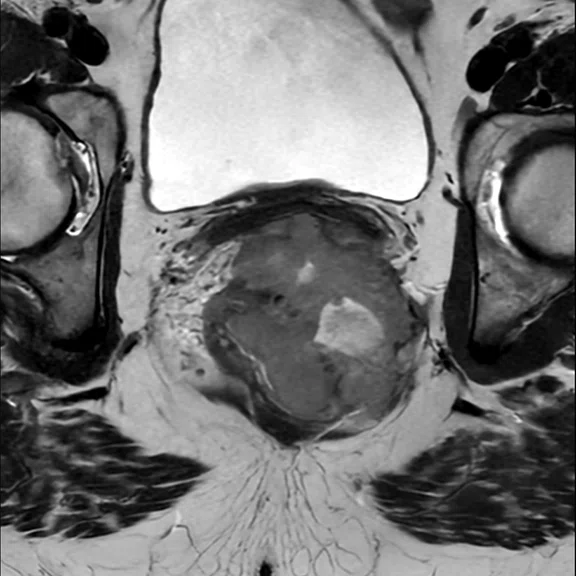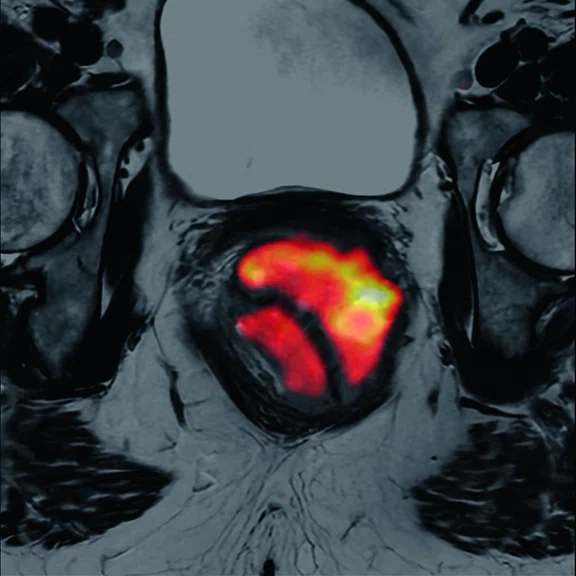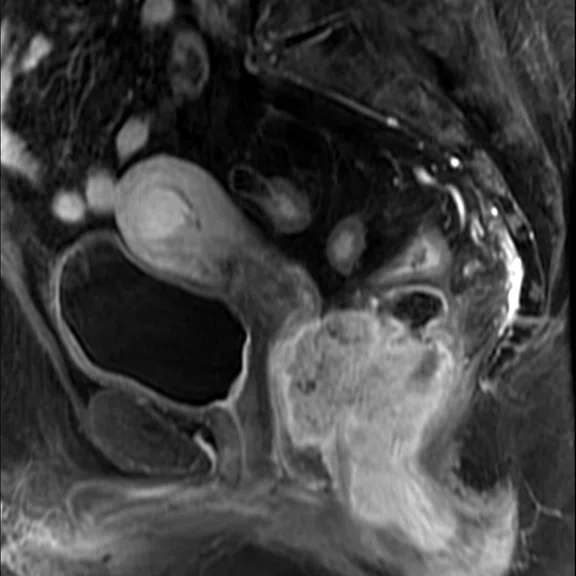A
Figure 1.
Prostate MR on a patient with bilateral hip replacements. (A) Coronal T2 FSE, 0.5 x 0.9 x 3 mm, 1:06 min,; (B) axial LAVA Flex post contrast, 1.1 x 1.8 x 3.93 mm, 21 sec. (C-E) axial DWI FOCUS, 2.2 x 1.8 x 4 mm, 3:27 min., (B) B800, (C) synthetic b1500 and (D) ACD map.
B
Figure 1.
Prostate MR on a patient with bilateral hip replacements. (A) Coronal T2 FSE, 0.5 x 0.9 x 3 mm, 1:06 min,; (B) axial LAVA Flex post contrast, 1.1 x 1.8 x 3.93 mm, 21 sec. (C-E) axial DWI FOCUS, 2.2 x 1.8 x 4 mm, 3:27 min., (B) B800, (C) synthetic b1500 and (D) ACD map.
C
Figure 1.
Prostate MR on a patient with bilateral hip replacements. (A) Coronal T2 FSE, 0.5 x 0.9 x 3 mm, 1:06 min,; (B) axial LAVA Flex post contrast, 1.1 x 1.8 x 3.93 mm, 21 sec. (C-E) axial DWI FOCUS, 2.2 x 1.8 x 4 mm, 3:27 min., (B) B800, (C) synthetic b1500 and (D) ACD map.
D
Figure 1.
Prostate MR on a patient with bilateral hip replacements. (A) Coronal T2 FSE, 0.5 x 0.9 x 3 mm, 1:06 min,; (B) axial LAVA Flex post contrast, 1.1 x 1.8 x 3.93 mm, 21 sec. (C-E) axial DWI FOCUS, 2.2 x 1.8 x 4 mm, 3:27 min., (B) B800, (C) synthetic b1500 and (D) ACD map.
E
Figure 1.
Prostate MR on a patient with bilateral hip replacements. (A) Coronal T2 FSE, 0.5 x 0.9 x 3 mm, 1:06 min,; (B) axial LAVA Flex post contrast, 1.1 x 1.8 x 3.93 mm, 21 sec. (C-E) axial DWI FOCUS, 2.2 x 1.8 x 4 mm, 3:27 min., (B) B800, (C) synthetic b1500 and (D) ACD map.
A
Figure 2.
Liver exam to evaluate large tumor. (A) Axial LAVA post contrast, 1.4 x 1.9 x 4.4 mm,
18 sec.; (B) coronal SSFSE breathhold, 1 x 1.8 x 4.5 mm, 18 sec. (C-E) axial MUSE, 3.5 x 3.2 x 7 mm, 2:24 min, (C) b400, (C) b800 and (E) ADC map.
B
Figure 2.
Liver exam to evaluate large tumor. (A) Axial LAVA post contrast, 1.4 x 1.9 x 4.4 mm,
18 sec.; (B) coronal SSFSE breathhold, 1 x 1.8 x 4.5 mm, 18 sec. (C-E) axial MUSE, 3.5 x 3.2 x 7 mm, 2:24 min, (C) b400, (C) b800 and (E) ADC map.
C
Figure 2.
Liver exam to evaluate large tumor. (A) Axial LAVA post contrast, 1.4 x 1.9 x 4.4 mm,
18 sec.; (B) coronal SSFSE breathhold, 1 x 1.8 x 4.5 mm, 18 sec. (C-E) axial MUSE, 3.5 x 3.2 x 7 mm, 2:24 min, (C) b400, (C) b800 and (E) ADC map.
D
Figure 2.
Liver exam to evaluate large tumor. (A) Axial LAVA post contrast, 1.4 x 1.9 x 4.4 mm,
18 sec.; (B) coronal SSFSE breathhold, 1 x 1.8 x 4.5 mm, 18 sec. (C-E) axial MUSE, 3.5 x 3.2 x 7 mm, 2:24 min, (C) b400, (C) b800 and (E) ADC map.
E
Figure 2.
Liver exam to evaluate large tumor. (A) Axial LAVA post contrast, 1.4 x 1.9 x 4.4 mm,
18 sec.; (B) coronal SSFSE breathhold, 1 x 1.8 x 4.5 mm, 18 sec. (C-E) axial MUSE, 3.5 x 3.2 x 7 mm, 2:24 min, (C) b400, (C) b800 and (E) ADC map.
A
Figure 3.
Rectal cancer patient, (A) axial T2 FSE, 0.6 x 0.9 x 3 mm, 2:13 min., (B) axial T2 FSE fused with MUSE DWI, 3.5 x 3.2 x 7 mm, 1:03 min. and (C) sagittal LAVA post-contrast, 0.8 x 1.4 x 3.88 mm, 1:30 min.
B
Figure 3.
Rectal cancer patient, (A) axial T2 FSE, 0.6 x 0.9 x 3 mm, 2:13 min., (B) axial T2 FSE fused with MUSE DWI, 3.5 x 3.2 x 7 mm, 1:03 min. and (C) sagittal LAVA post-contrast, 0.8 x 1.4 x 3.88 mm, 1:30 min.
C
Figure 3.
Rectal cancer patient, (A) axial T2 FSE, 0.6 x 0.9 x 3 mm, 2:13 min., (B) axial T2 FSE fused with MUSE DWI, 3.5 x 3.2 x 7 mm, 1:03 min. and (C) sagittal LAVA post-contrast, 0.8 x 1.4 x 3.88 mm, 1:30 min.


result
PREVIOUS
${prev-page}
NEXT
${next-page}
Subscribe Now
Manage Subscription
FOLLOW US
Contact Us • Cookie Preferences • Privacy Policy • California Privacy PolicyDo Not Sell or Share My Personal Information • Terms & Conditions • Security
© 2024 GE HealthCare. GE is a trademark of General Electric Company. Used under trademark license.
IN PRACTICE
A multi-disciplinary, patient-centered approach to prostate MR imaging
A multi-disciplinary, patient-centered approach to prostate MR imaging
What began as an oncology practice has morphed into one of the largest and most successful prostate MR imaging programs in Long Island at New York Cancer & Blood Specialists (NYCBS), one of the nation’s leading community cancer centers.
What began as an oncology practice has morphed into one of the largest and most successful prostate MR imaging programs in Long Island at New York Cancer & Blood Specialists (NYCBS), one of the nation’s leading community cancer centers.
More than six years ago, the center’s leadership was frustrated with the lack of access to advanced PET/CT in the area, with hospitals being the only provider of this high patient cost imaging service. They found the delay in reporting was excessive, patient financial responsibilities were exorbitant and communication between the physician and radiologist was less than desired.
So, NYCBS invested in its own PET/CT systems from GE Healthcare in three different clinic locations.
According to Timothy Wintz, RT(R)(MR), Senior Vice President of the Eastern Division, “Our patients loved the fact they didn’t have to go elsewhere for their imaging. Then, about four years ago, our CEO wanted to expand the program and bring in CT, MR and ultrasound.”
NYCBS opened its first imaging center in Port Jefferson and formed NY Imaging Specialists as a subsidiary. Although known by a different name, NY Imaging Specialists brought the same approach that NYCBS was renowned for: multi-disciplinary, high-quality care with the patient at the center.
“Referrers started to notice the fast turnaround times that we provided, from days with other groups to six to eight hours with us, as well as the focus on communication between clinicians,” Wintz adds.
As NY Imaging grew and added new centers, including the New Hyde Park site with two SIGNA™ Pioneer 3.0T MRs, the organization continued to invest in advanced imaging to meet
the needs of patients and providers. When AIR™ Recon DL and AIR™ Coils became available for the SIGNA™ Pioneer, the center made the leap to the SIGNA™Works AIR™ IQ Edition upgrade.
“Since the upgrade, we are scanning 15-17 patients per scanner, per eight-hour day at New Hyde Park,” Wintz says. “These are not your typical, basic exams; we are scanning a high volume of specialized body and neuro oncology patients. And we aren’t rushing the patients in and out; we take the time to talk to them and make sure they are comfortable. We are able to do this because the GE MR systems and AIR™ Recon DL enable us to scan quickly with great image quality.”
Long Island is a very competitive market in the US for outpatient imaging, with numerous providers and centers. AIR™ Recon DL and AIR™ Coils have helped NY Imaging differentiate from other sites with fast, high-quality exams that patients and referrers appreciate.
With the AIR™ Coil, the technologist can use one coil to scan the abdomen and pelvis, even on patients who are six feet tall. For prostate exams, the technologists do not have to enter the scan room and center the coil – they can just keep scanning.
NY Imaging’s radiologists are also appreciative of the quality derived from AIR™ Recon DL. In fact, it is one upgrade that Wintz has yet to have any resistance to. He explains that the radiologists get so accustomed to reading an image one way that when it’s adjusted due to an upgrade, even if it is better, they don’t necessarily immediately like it. But that didn’t happen with AIR™ Recon DL. The radiologists were incredibly impressed and couldn’t believe the scanner was providing the high-quality images in the short scan times.
“We increased our speed, our quality and throughput,” says Wintz. “It was like going against the rules in MR with AIR™ Recon DL because we didn’t have to lose something to gain elsewhere. There were no compromises.”
In fact, when Matthew Comito, MD, joined the practice earlier this year, he told Wintz that he was not only impressed by the patient volume but also with the quality of the studies.
Dr. Comito previously worked at large academic institutions. He completed a fellowship in abdominal imaging and intervention at Duke University Hospital, and was chief resident at Stony Brook University Hospital.
“Most of the abdominal MR imaging we do at NY Imaging is prostate and it is a very high-volume service, especially considering our size,” Dr. Comito says.
The prostate program initially got a big boost when Anthony Gilet, MD, Chief of Body Imaging at NY Imaging, joined the practice three years ago after being Director of MRI and CT at Westchester Medical Center/New York Medical College. He was also chief resident at Stony Brook University Hospital several years prior to Dr. Comito.
“Because our technology is cutting-edge and our technologists are familiar with prostate imaging, there is really no patient that we cannot scan,” Dr. Gilet says. This includes patients with MR- Conditional bilateral hip prosthetics, those who are anxious or claustrophobic, and older patients who may have issues laying in the same position for any period of time. He credits the center’s highly skilled technologists who get patients on and off the MR table quickly, yet make them feel comfortable and relaxed, and know how to troubleshoot on the fly when they encounter a more difficult case.
Dr. Gilet was trained to use the endorectal coil in prostate exams as a necessary component. However, he notes that this coil is not always optimal for prostate imaging because it can be positioned close only to the posterior aspect of the gland. Other areas of the gland were not imaged as well, and the radiologist had to contend with device artifact. NY Imaging no longer uses the endorectal coil, which not only saves time, but also staff costs as another person was needed for the coil insertion and removal.
“Now we are getting better images in a much quicker time with much more patient comfort – and that means we can turn over patients in the MR room that much faster,” Dr. Gilet says.
The difference resulting from the addition of AIR™ Recon DL and the AIR™ Anterior Array (AA) Coil was immediately noticeable to Dr. Gilet. The new software was installed on the SIGNA™ Pioneer at the Port Jefferson location before the New Hyde Park site. “There was never a difference in image quality between our 3.0T MR systems,” explains Dr. Gilet. “But then I noticed the difference and realized it was due to AIR™ Recon DL and the AIR™ Coil. The axial T2 and diffusion-weighted images are stellar with really good contrast definition and excellent spatial resolution. I think we are detecting more smaller lesions than before because previously these were either just below the resolution or slight motion artifacts could obscure them. There was just not enough contrast with the background tissue. Now, I’m consistently contouring smaller lesions than I was before.”
The two key workhorse sequences that Dr. Gilet uses to make 95% of his diagnoses are significantly shorter. The axial T2 sequence takes approximately 75 seconds with high resolution, and the DWI sequences take three minutes with significantly reduced artifacts due to using AIR™ technologies. The fast exams and higher SNR have helped further reduce motion, peristalsis and susceptibility artifacts from all prostate exams.
“The fact we can image the patients more quickly means we can see that many more each day. That benefits the patients because they can have an MR before biopsy,” Dr. Gilet adds.
Both DISCO and LAVA are used interchangeably in prostate exams; however, LAVA is often the sequence of choice when the abdomen is scanned along with the prostate.
The high quality of the prostate exams also impacts reading time.
“The lesions have become so conspicuous that it takes us less time to make a diagnosis, especially with the diffusion sequences,” adds Dr. Comito. “In some cases, diffusion almost looks like a high- resolution T2-weighted image. We can read through a lot of cases with a high level of confidence because the lesion almost pops out using diffusion on the ADC maps.”
With no endorectal coil and fast exams, Drs. Comito and Gilet believe that active surveillance can play a key role in managing patients with less-aggressive prostate lesions. They also believe patients will continue to return for repeat MR exams now that they are fast and comfortable.
“The feedback I’ve received from our urology referrers is that we have the best lesion marking and the highest image quality that they have seen,” Dr. Gilet adds. “That gives them a higher degree of confidence when they are putting a patient on active surveillance because they know the follow-up imaging is going to be high quality, timely and reliable.”
Across all sites, the practice is averaging 20 prostate exams each day, benefitting not just NY Imaging and the urology referrers, but the patients as well.
“Cancer screening patients are very savvy. They know what services are available and they understand the procedures they will undergo,” adds Dr. Gilet. “So, the fact we can see the urologists’ patients within a short period of time, scan them quickly on MR, and then provide a rapid turnaround time with our reads, really allows these patients to be appropriately screened. It is important for patients to understand there are a lot of tools for cancer detection and surveillance, and they should go where decisions are being made in a multi-disciplinary fashion with the highest quality of care.”

















